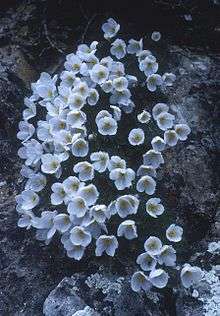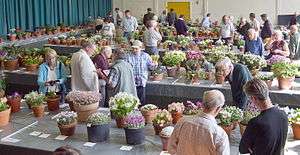Alpine Garden Society
The Alpine Garden Society is a society based in the United Kingdom, with its headquarters at Pershore, Worcestershire. It describes itself as an "International Society for the cultivation, conservation and exploration of alpine and rock garden plants, small hardy herbaceous plants, hardy and half-hardy bulbs, hardy ferns and small shrubs".[1]
 | |
| Abbreviation | AGS |
|---|---|
| Formation | 10 December 1929 |
| Type | Registered charity |
| Purpose | To promote the cultivation, conservation and exploration of alpine and rock garden plants, small hardy herbaceous plants, hardy and half-hardy bulbs, hardy ferns and small shrubs |
| Headquarters | Pershore, Worcestershire |
Region served | United Kingdom; significant numbers of international members |
| Website | http://www.alpinegardensociety.net |
It publishes a quarterly journal, now titled The Alpine Gardener. Many alpine plants are easy to grow. This makes "alpine gardening" a good introduction to plants for those who are short of the space and/or time to devote to gardening on a larger scale. The Alpine Gardener contains well written articles for those with less experience or time, although of course the majority of the content is targeted at the more dedicated enthusiast. These latter can still be enjoyed for their enthusiasm and the very high standard of photography that is maintained by the AGS.
What is an alpine plant?

Providing a pragmatic definition of an Alpine plant, in the context of the AGS, is a little difficult. Strictly speaking, an Alpine is a plant that occurs in the region above the tree line and below permanent snow in mountainous regions. Within temperate and boreal regions, the alpine zone can be subdivided into three zones, each with characteristic vegetation types: Lower alpine, with bush and tall herb communities; Middle alpine, in which sedges, grasses and heath species dominate; and, Upper alpine, with dwarf herbaceous, prostrate woody plants, lichens and mosses.[2] The zonation in tropical and sub-tropical mountains differs significantly and the plants of these zones tend to fall without the domain of interest of AGS members.
This provides plenty of scope for growing plants of diverse size and form. However, species of many of the genera of interest can be found at lower altitudes too. For example, many bulbous plants (or more strictly, geophytes) flower as snow recedes (or as rain begins to fall on the cool down towards snow-falls in the autumn). The timing of this, of course, varies with altitude, and as a result attractive and garden-worthy examples can be found from mountain foothills right up to the upper alpine zones. So we see the alpine enthusiast growing a wide range of the three "Cs" - Crocus, Colchicum, Cyclamen - in order to provide colour and interest through autumn, winter and spring. And so the interest continues to grow, with many plants that are well-suited to the alpine or rock garden having their origins from way outside the alpine zones of the world.
As a result of this quite natural expansion of enthusiasm, the AGS has steadily expanded its domain of interest to include "small hardy herbaceous plants, hardy and half-hardy bulbs (more strictly geophytes), hardy ferns and small shrubs". This in turn has led to a long-term debate about whether or not the AGS should change its name to reflect its evolution into a society with very catholic interests. Nevertheless, alpine plants sensu stricto remain a core and common interest to the members of the society, and so are central to its identity.
The AGS Encyclopaedia of Alpines and Other Hardy Plants
The AGS first published its Encyclopaedia of Alpines in 1993. This two-volume work became a standard reference, in many ways defining the domain of interest to AGS members. This work is now available in an extended version online as The AGS Encyclopaedia of Alpines and Other Hardy Plants. The addendum to the title indicates one of the challenges the AGS has had for many years - the range of plants that are of interest to its members continues to expand beyond the strict definition of Alpine Plants, as discussed above. This can make it hard for a non-member to appreciate the scope of activities of the Society. However, this online work is freely available and can continue to expand and act as an evolving definition of the Society's domain of interest. Currently the officers of the Society maintain editorial control of the Encyclopaedia. However, members can comment on articles and plans are in place for members to submit proposals for content at the article level.
Plant shows
Organised plant shows are a well established way for plant and gardening enthusiasts to show off their growing skills and to meet and exchange knowledge. The AGS organises shows for Alpine and Rock Garden plants at a range of venues in England, Wales and Ireland. These take place throughout the year, with a particularly high frequency of events during the February to May period. The shows will typically include a plant fair where nurseries that specialise in alpine and rock garden plants offer plants for sale. A visit to one of these shows provides an excellent introduction to the world of the AGS. The Society’s web site provides a complete list of dates and venues.
Exhibiting at these shows is a specialised activity because the plants need to be grown in pots or other containers, which can be a more time consuming activity than growing plants in the open garden. The AGS has been running an online plant show since 2006. This enables those with less time to display images of their plants and receive feedback from expert judges and from the community of members. Images of plants growing in the open garden, and of gardens themselves, may be submitted.
The AGS itself also regularly acts as an exhibitor at the UK’s Chelsea Flower Show. The combination of talented designers and the expert growing skills of the members always results in an award winning stand, including the President's Award for best display in the Marquee in 2008.
Alpines for children
One of the appeals of alpines is that it is possible to make a complete garden in the space taken by a single shrub. This not only makes them attractive to the smaller gardens of modern times, but also has potential to draw children into the world of horticulture. Indeed, there are good indications that the combination of small plants and mighty mountains captures their imagination.
For example, 300 children from 12 schools took part in the 2014 Alpine Garden Society show at Malvern, UK. The brief given to the schools was for a small trough planted up with alpines. However, as well as some wonderful little landscapes, the children came to the show with a whole range of artwork, posters, booklets and essays. They had prepared these to summarise their individual researches into alpines and the places where they grow.
There are some very positive movements to draw children into learning the life-skills of horticulture by the Royal Horticultural Society, Writhlington School and others. The indications are that the work of the AGS could add a new dimension to this.
History
1929 to 1989
The society was founded in 1929. Sir William Lawrence, who was at the time the treasurer of the Royal Horticultural Society, first suggested creating a "rock garden society" in June 1929. The first general meeting was held on 10 December 1929, when the name was changed to its present one, as its principal purpose was to be to encourage the cultivation of alpine plants. Lawrence became the society's first president.[3][4]
Within five months, on 5 April 1930, the society held its first show, a tradition which has continued since. Exhibitors compete for awards, including the Sewell Medal and the Farrer Memorial Medal, introduced in 1931. Non-competitive displays have been included from 1931 onwards.[5]

From the beginning the society supported expeditions which involved collecting plants from the wild for introduction into cultivation. The support sometimes took the form of individual members taking shares in an expedition by providing finance in return for a proportion of the material which was collected. The society also organized its own tours, beginning in 1933 with a tour to Snowdonia. Tours continue today, although with changed attitudes to conservation, the society does not allow collecting on its tours.[5]
The first "bulletin" was produced in 1930, containing only 13 pages. The size rapidly increased. From 1930 to 1944 (Volumes 1 to 12 – not one per year) it was called the Bulletin of the Alpine Garden Society; from 1945 (Volume 13), "Quarterly" was added to the title and it became the Quarterly Bulletin of the Alpine Garden Society.[6] The Bulletin contained (and continues to contain) articles of various kinds, including reports of the Society's shows, information on cultivating plants which fall within the society's remit, and accounts of such plants in the wild. Photography was an important aspect of the Bulletin, initially confined to black-and-white, such as the picture of Ramonda myconi (then called R. pyrenaica) in the second Bulletin. Although there were earlier experiments with colour printing, colour was not used in earnest until 1984.[5]
The society produced other publications from the earliest days. Initially these were obtained by reprinting material from the Bulletin as a separate work. The first was The Scree Garden in 1933.[7] In later years, the Society supported the publication of more overtly scientific works, such as the monograph on the genus Daphne by Christopher Brickell and Brian Mathew.[8] A subsidiary of the society, AGS Publications, was set up and had a turnover of more than £70,000 by 1989.[5]
One of the society's early scientific activities was evaluating plants which fell within its scope for their suitability for cultivation and their merits when cultivated. The society alone first issued the award of Certificate of Merit and Botanical Certificate in 1933. The Royal Horticultural Society regarded itself as the legitimate UK body to make such awards, and in 1936, a joint committee was set up, affectionately known as the "Joint Rock" (officially the Joint Rock Garden Plant Committee), which makes awards such as the Award of Garden Merit (AGM). Another activity with a scientific flavour introduced in 1936 was the three-day international conference.[5]
Local secretaries were first introduced in 1936, which later resulted in local groups,[5] affiliated to the main AGS, but allowing a limited number of people to join the local group but not the main AGS.
References
- Anon. (2011), "Preface", The Alpine Gardener, 79 (2): 210
- Crawford, R.M.M. (2008). Plants at the Margin: Ecological Limits and Climate Change. Cambridge University Press. ISBN 978-0-521-62309-4.
- "Euphrasia" (1989), "Alpine Anthology", Quarterly Bulletin of the Alpine Garden Society, 57 (1): 3
- Elliott, Brent, The Royal Horticultural Society, a History 1804-2004, Phillimore, ISBN 978-1-86077-272-6
- Bird, Roger (1989), "The Alpine Garden Society : the first years", Quarterly Bulletin of the Alpine Garden Society, 57 (1): 20–24
- See the relevant volumes.
- Fisher, F.H. (1933), The Scree Garden, Alpine Garden Society, OCLC 651876864
- Brickell, Christopher & Mathew, Brian (1976), Daphne : the genus in the wild and in cultivation, Woking, England: Alpine Garden Society, ISBN 978-0-900048-23-4